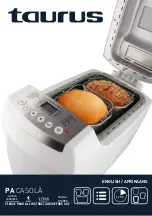
The Art of Baking Great Tasting Bread.
•
The ingredients in basic bread are very simple: flour,
sugar, salt, liquid (such as water or milk), possibly a
fat (such as butter or margarine), and yeast. Each of
these ingredients performs a specific job, and each
lends a special flavour to the final masterpiece.
That’s why it is important to use the right
ingredients in exactly the right proportions to
ensure you get the most delicious results!
Yeast
•Yeast is actually a microscopic plant. Simply
stated,without yeast, your bread will not rise. When-
moistened by a liquid, fed by sugar and careful-
lywarmed, yeast produces gasses that power the
dough to rise. If the temperature is too cold, the yeast
will not be activated, if it’s too warm, it will die. Your
Breadmaker takes care of this worry for you by main-
taining just the right temperature in the baking cham-
ber at all times.Some yeasts may require the use of
a bread improver. The Bread Improver will provide
additional gluten to the flour to produce a better loaf.
Note:
We do not recommend the use of fresh or
compressed yeast in your breadmaker. Taurus recom-
mends the use of dry yeast only. Always
ensure it is used well within the use-by date, as
stale yeast will prevent the bread from rising.
Flour
•
In order for the bread to rise, the flour has to have a
sufficiently high protein content. Taurus Breadmaker
recommends the use of a good quality plain or bread
flour. Some recommended brands are listed on page
22. Unlike white flour, wheat flour contains bran and
wheatgerm which are heavy and inhibit rising. Wheat
breads therefore, tend to be heavier intexture and
smaller in size. A lighter larger loaf can be achieved
by combining wheat flour with white flour for whole
wheat bread recipes.
Sugars
•
Sugars sweeten the bread, brown the crust, lend-
tenderness to the texture and supply the yeast with-
food. White or brown sugar, molasses, maple or
golden syrup, honey and other sweeteners may be
used in equivalent quantities.
Note:
Artificial sweetener can be substituted in
equivalent amounts, however the taste and texture
of your bread will vary.
Liquids
•
When liquids are mixed with the proteins in flour, glu-
ten is formed. Gluten is necessary for the bread to
rise. Most recipes use powdered milk and water, but
other liquids such as milk, fruit juice, beer and water
can be used. It’s a delicate balance: experiment with
quantities of these liquids to obtain optimum results
as a recipe with too muchliquid may cause the bread
to fall during baking while a recipe with too little liq-
uid will not rise.Note: Liquids should be used at room
temperature.
The Art of Baking Great Tasting Bread
Salt
•
In small amounts, salt adds flavour and controls yeast
action. Too much salt inhibits rising, so be sure to
measure amounts correctly. Any ordinary table salt
may be used.
Fats
•
Many breads use fats to enhance the flavour and
retain moisture. Typically, we mostly use margarine
in the recipes; softened butter or oil may be used in
equivalent quantities.
Note:
If you choose not to add any fat, your bread
may vary in taste and texture.
Important measuring tips.
•
Each ingredient in a loaf of bread plays a specific role,
so it is extremely important to measure the ingredi-
ents correctly to get the best results.
Dry Ingredients
•
Use a standard metric measuring spoon or measur-
ing cup. Do not use tableware spoons or coffee cups
and level off. For flour simply spoon the flour loosely
into the measuring cup and level off with a flat knife.
Do not pack dry ingredients down into the cup or tap
the cup unless otherwise stated in the recipe.
Liquids
•
Fill a standard metric measuring spoon ormeasuring
cup to the level indicated. Check your cupmeasure-
ment by placing the measuring cup on a flatsurface
and reading the measurement at eye level.
Solid fats
•
Fill a standard metric measuring spoon or measuring
cup to the level indicated and level off with a flat knife.
Last Things Last!
•
Always place the liquids in the bread pan first, the dry
ingredients in next, and the yeast in last. This will en-
sure a well risen and evenly baked loaf.
Fruit and Nut Dispenser
•Your Taurus Breadmaker has an automatic Fruit &
Nut dispenser which automatically releases dryin-
gredients into the dough during the kneading cycle.
This will occur approximately 8 minutes before the
completion of knead 2, ensuring that the dried fruits
& nuts are not crushed and the pieces remain whole
and are evenly dispersed. The capacity of the fruit &
nut dispenser is 1 cup of dry ingredients and is an
available option on all menu settings but we recom-
mend use only on the Basic (1), Gluten/Yeast Free
(3), Wheat (4) and Sweet Bread (5). The Fruit & Nut
dispenser is yet another feature of your Taurus Bread-
maker which was designed for, added convenience to
you, taking the guess-work out of recipes.
Fruit and Nut Dispenser cannot be used with 2 small






































